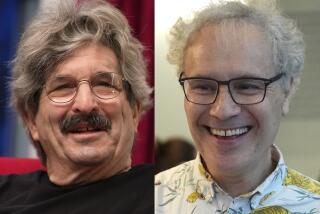Caltech Chemist Wins Nobel Prize for Facilitating a Molecular Dance
Robert H. Grubbs of Caltech was awarded the 2005 Nobel Prize in chemistry Wednesday for his role in developing the intricate molecular dance called metathesis, a novel technique that makes it easier and cheaper to create synthetic substances while sharply decreasing the amount of waste materials.
Grubbs shares the award with Richard R. Schrock, an MIT professor who spent his undergraduate years at UC Riverside, and Yves Chauvin, a theoretical chemist at the Institut Francais du Petrole in Rueil-Malmaison, France.
Metathesis, which means “changing places,” involves chemical reactions in which two carbon-based molecules exchange fragments under the influence of a catalyst, a third molecule that promotes the reaction without itself being consumed.
In normal use, the technique can add a large fragment containing many atoms to a separate, growing molecule in one step rather than the many that would have previously been required.
Metathesis “represents a great step forward for ‘green chemistry,’ reducing potentially hazardous waste through smarter production,” the Nobel committee said in making the announcement.
“Metathesis reactions are an important tool in the creation of new drugs to fight many of the world’s major diseases, including cancer, Alzheimer’s and AIDS,” added American Chemical Society President William F. Carroll Jr. “They also are used to develop herbicides, new polymers and fuels.”
Grubbs, 63, is in Christchurch, New Zealand, for a month lecturing at the University of Canterbury. He said he had just gotten back from “a whistle-stop tour of the North Island” when he got the call Wednesday evening.
“I had just opened a bottle of good port,” he said in a telephone interview, “so I continued drinking it.”
He said he had not really given any thought to what he would do with his share of the $1.3-million prize. “But I have already gotten an e-mail from my tax lawyer,” he added.
Chauvin, 74, who is now retired in Tours, France, told reporters that he felt “embarrassment, not joy.... I had a quiet life. Now I see that that is no longer the case.”
He added: “Today I live alone, and my first thoughts go to my wife, who passed away barely a year ago.”
Schrock, 60, said he was “very excited, very nervous,” when he was awakened Wednesday by the call from Stockholm. “When the phone rings at 5:30 in the morning, you know it is very good news or very bad news,” he said. “Fortunately, this was very good news.”
Metathesis has been known to chemists for at least 40 years, but only in the last 10 have chemists been able to use it in a predictable manner.
First observed spontaneously in polymerization reactions in the petrochemical industry, the technique was a hit-and-miss process because researchers did not really know what was going on.
Chauvin developed the first theoretical explanation for the process, concluding in 1970 that metathesis is catalyzed by a family of chemicals called metal carbenes, in which a metal atom is bonded to a carbon atom through a double bond.
In the intricate dance, the metal-carbon double bond in the catalyst binds to a carbon-carbon double bond in the target molecule, forming a ring containing four atoms.
The metal atom then attacks the carbon-carbon bond in the molecule to be added to the target.
Ultimately, the two crucial fragments are joined together, the metal carbene is spit out intact and ready for another cycle, and the unneeded parts of the original molecules are joined together as a waste product.
In an unusual demonstration at the Royal Swedish Academy of Sciences’ news conference announcing the prize, two couples danced quietly, then joined hands before changing partners, forming two new couples.
“This is a synthetic method to make compounds that couldn’t be made otherwise or that could only be made with very great difficulty,” MIT chemist Dietmar Seyferth said. “The chemistry is absolutely unique.”
Inspired by Chauvin’s report, Schrock began searching for catalysts that could carry out the reaction in a predictable manner. He tried a variety of metals before concluding that molybdenum and tungsten were probably the best.
In 1990, he reported the discovery of a group of molybdenum carbenes that proved effective. But the catalysts were not particularly stable in air and were incompatible with many commonly used solvents.
Grubbs solved those problems by developing a family of ruthenium carbenes that were much more stable and that could be used in alcohols and water. One of these compounds, commonly called Grubbs’ catalyst, is the standard against which all new catalysts are compared.
“The two [types of catalysts] are very complementary,” Seyferth said. “One can do what the other can’t.”
Grubbs said that Cargill Inc., which produces several types of vegetable oils, is using the technology to convert them into products normally made from petroleum. Several complex drugs made using the technique are now in the second phase of clinical trials and could be on the market in a few years, he said.
And in a more unusual application, Easton Sports Inc. of Van Nuys is using the technology to make a plastic baseball bat.






